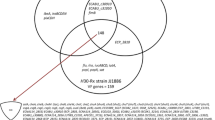Abstract
Male CD-1 mice, fed streptomycin in their drinking water, were used to study colonization of the mouse intestine by both fecalEscherichia coli strains isolated from healthy humans andEscherichia coli K12 strains which are routinely used as hosts for recombinant DNA. Prior to use in mice, all the strains were made resistant to streptomycin. Several facts emerged from these studies: (a) Strains isolated from different healthy humans colonized the mouse intestine with equal ability (approximately 108 cells/g feces), but may have colonized biochemically distinct sites. (b) K12 strains tested had, at most, one hundredth the colonizing ability of human fecal strains. (c) Rifampicin-resistant mutants of strains which contain one or no plasmids were poor colonizers relative to their parents. (d) Rifampicin-resistant mutants of strains which contain six or more plasmids retained the colonizing abilities of their parents. (e) Introduction of the F-amp or pJBK5 plasmid into HS-4, a human fecal strain which does not normally carry these plasmids, reduced its colonizing ability 1000-fold. (f) Strains used in this study colonized the mouse caecum and colon exclusively. The system presented here offers a simple, rapid test to determine whether a specific genetic alteration in a bacterium (e.g. antibiotic resistance) results in enhanced, reduced, or unchanged colonizing ability. Such a test might prove to be of value as a part of the clinical testing of antibiotics.
Similar content being viewed by others
References
Hartley, C. L., Newmann, C. S., Richmond, M. H.: Adhesion of commensal bacteria to the large intestine wall in humans. Infection and Immunity 1979, 23: 128–132.
Anderson, J. D., Gillespie, W. A., Richmond, M. H.: Chemotherapy and antibiotic-resistance transfer between enterobacteria in the human gastrointestinal tract. Journal of Medical Microbiology 1973, 6: 461–473.
Burton, G. C., Hirsh, D. C., Blenden, D. C., Ziegler, J. L.: The effect of tetracycline on the establishment ofEscherichia coli of animal origin, and in vivo transfer of antibiotic resistance, in the intestinal tract of man. In: Skinner, F. A., Carr, J. C. (eds.): The normal microbial flora of man. Academic Press, New York, 1974, p. 241–253.
Freter, R.: Possible effects of foreign DNA on pathogenic potential and intestinal proliferation ofEscherichia coli. Journal of Infectious Diseases 1978, 137: 624–629.
Meynell, G. G., Subbaiah, T. V.: Antibacterial mechanisms of the mouse gut. I.: Kinetics of infection bySalmonella typhimurium in normal and streptomycin-treated mice studies with abortive transductants. British Journal of Experimental Pathology 1963, 44: 197–208.
Meynell, G. G.: Antibacterial mechanisms of the mouse gut. II.: The role of Eh and volatile fatty acids in the normal gut. British Journal of Experimental Pathology 1963, 44: 209–219.
Miller, C. E., Wong, K. H., Feeley, J. C., Forlines, M. E.: Immunological conversion ofVibrio cholerae in mice. Infection and Immunity 1972, 6: 739–742.
Schaedler, R. W., Dubos, R., Costello, R.: Association of germfree mice with bacteria isolated from normal mice. Journal of Experimental Medicine 1965, 122: 77–82.
Dufour, A. P., Strickland, E. R., Cabelli, V. J.: Membrane filter method for enumeratingEscherichia coli. Applied and Environmental Microbiology 1981, 41: 1152–1158.
Levine, M. M., Bergquist, E. J., Nalin, D. R., Waterman, D. H., Hornick, R. B., Young, C. R., Sotman, S., Rowe, B.:Escherichia coli strains that cause diarrhoea but do not produce heatlabile or heat-stable enterotoxins and are noninvasive. Lancet 1978, i: 1119–1122.
Revel, H. R.: Restriction of nonglucosylated T-even bacteriophase: properties of permissive mutants ofEscherichia coli B and K12. Virology 1966, 31: 688–701.
Guerry, P., LeBlanc, D. J., Falkow, S.: General method for the isolation of plasmid deoxyribonucleic acid. Journal of Bacteriology 1973, 1064–1071.
Meyers, J. A., Sanchez, D., Elwell, L. P., Falkow, S.: Simple agarose gel electrophoretic method for the identification and characterization of deoxyribonucleic acid. Journal of Bacteriology 1976, 1529–1538.
Wilkins, T. D., Appleman, M. D.: Review of methods for antibiotic susceptibility testing of anaerobic bacteria. Laboratory Medicine 1976, 7: 12–15.
Ozaki, M., Mizuchima, S., Nomura, M.: Identification and functional characterization of the protein controlled by the streptomycin-resistance locus inEscherichia coli. Nature 1969, 222: 333–339.
Savage, D. C.: Microbial ecology of the gastrointestinal tract. Annual Review of Microbiology 1977, 31: 107–133.
Curtiss, R. III.: Biological containment and cloning vector transmissibility. Journal of Infectious Diseases 1978, 137: 668–675.
Smith, H. W.: Survival of orally administeredEscherichia coli K-12 in the alimentary tract of man. Nature 1975, 255: 500–502.
Smith, H. W.: Is it safe to useEscherichia coli K12 in recombinant DNA experiments? Journal of Infectious Diseases 1978, 137: 655–660.
Levy, S. B., Marshall, B., Rowse-Eagle, D.: Survival ofEscherichia coli host-vector systems in the mammalian intestine. Science 1980, 209: 391–394.
Onderdonk, A., Marshall, B., Cisneros, R., Levy, S. B.: Competition between congenicEscherichia coli strains in vivo. Infection and Immunity 1981, 32: 74–79.
Watanabe, T., Sugawara, K., Watanabe, M.: Virulence of rifampicin resistant mutants of bacteria. Japanese Journal of Microbiology 1971, 26: 192–199.
Author information
Authors and Affiliations
Rights and permissions
About this article
Cite this article
Myhal, M.L., Laux, D.C. & Cohen, P.S. Relative colonizing abilities of human fecal and K 12 strains ofEscherichia coli in the large intestines of streptomycin-treated mice. Eur. J, Clin. Microbiol. 1, 186–192 (1982). https://doi.org/10.1007/BF02019621
Issue Date:
DOI: https://doi.org/10.1007/BF02019621




